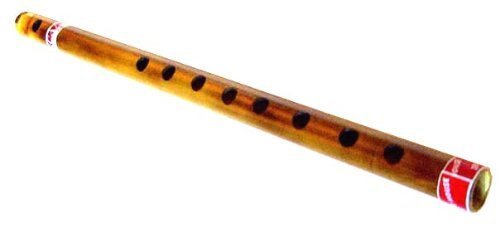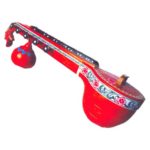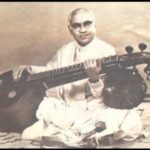Sangeeta has a special place in the hearts of the Andhras. From composer saints such as Annamacharya to vaageyakaara sarvabhaumas such as Syama Sastri, the music of our land defines much of our culture. In light of that, we started a Series on Carnatic Classical Instruments, beginning with the Veena. But the counterpart to that string instrument is a windy vaadhya that no vaadhyabrndha is complete without.
Better known as the Flute, this next Carnatic Classical Instrument is known by many Classical names. Though familiar to our Northern brothers as the Bansuri, the bamboo flute in the Sanskritic South is called Venu, Venuvu, Vamsee, as well as Pulangoil & Pulanguzhal in Tamil, and of course the most famous of all…Murali, among many other appellations. But for orthodoxy’s sake we will primarily call it by the first one: Venu.
Introduction
As stated by Swami Prajnanananda, Natya proper is Histrionics. [6, 97] Though in modern parlance it is all too often restricted merely to dance, as evidenced by the treatment of topics in Bharata Muni’s encyclopedic work, it is much more than that.
Much as Sthaapatya Veda contains Vaastu which contains Silpa which contains Chitra, we see the same here. Within Gandharva Veda (Performance Arts) is contained Natya (Histrionics) within which is contained Nataka (Dramatics), as well as Nrtya (Dance), Nrtta (Pure Rhythmic motion), Abhinaya (Facial expression), and Sangeeta (Music).
The Musical instrument (Aathodhya or Vaadhya) [2,110] in Carnatic music is of four kinds: Thatha vaadhyam, Sushira vaadhyam, Avanatta vaadhyam, and Ghana vaadhyam. “They are respectively called stringed instruments, thulai (hole) instruments, leather instruments and metal instruments.”[1, 97]
Sushira (thulai) instruments are wind instruments & typically are made either out of wood or bamboo planks. They have holes, are blown from the mouth, and manipulated with the fingers. Instruments such as the flute (murali or venu) fall into this category. “Depending on the number of quartertones, the notes of this instrument are of three varieties—dvika or two, trika or three and catushka or four. The same are respectively known as ardhamukta or half open, kampamaana or pulsating, and vyakta mukta or fully open.”[2,110-111]
History
https://www.youtube.com/watch?v=W_PtnXsq6bg
It is said that creation originates in the union of Shiva-Shakti resulting in Bindu (cosmic drop) then Spanda (vibration), then Nada (meaning mellifluous sound). Nada (pronounced naadha) is the very essence of the Venu (Classical Flute). Both man and nature are in harmony in this most mellifluous of instruments. It is not for nothing that the bamboo flute is also called naadhi.
Nada is classified under two types, Ahatha Nada (man-made) and Anahatha (natural). When we play an instrument that is in tune with sruthi, it is called Ahatha Nadam. [1, 8-9] Anahatha Nadam represents sound created in nature: “In the bamboo forests air enters the bamboo that is cut and a sound emanates“. [1,9] Thus, the bamboo flute is a beautiful combination of Ahatha and Anahatha. A mukhari is any instrumentalist.
Contrary to some, the flute is not a new addition to Sangeeta kutapas (instrumental ensembles) or vaadhyabrndas (formal orchestras). As Jaya Senapati states in his Nrtta Ratnavali, the flute has long been a part of instrumental performances:
Tasyaanuvaadakaadyaasca bhaveyurvaamapaarsvatah |
tisthetaam mukhyagaayinyau paatrapaascaatyabhaagatah ||
etayoh parsvayostaaladharaa praudhaah kalaadishu |
tatprsthe vaamshikaah kaamsyadharaah syuranugaayikaah ||
“To his left stand the mrdanga players in order. Behind them the hudukka, conch, deseepata, karata drum, trumpet, and brass cymbal players stand in that order. In the same way, on the left stands the pratimukhari. His followers stand with him. On both their sides stand the experienced and knowledgeable taala experts, trailing them are the flautists and the cymbal players. “[5, 470]
Furthermore, Jaya Senapati states these as qualities for a quality instrumentalist:
“The following are the qualities needed of a Mukhari or an instrumentalist; To be in knowledge of the count of the characters in a rhythmic cycle, to be acquainted with Mayuri, Arthamayuri and Kaarmaaravi, the three Maarjanams or procedures to produce solfa syllables, steady dexterous with the hands, capacity to compose instrumental music, comply with the mood of the character, skill at bringing the group together harmoniously, armed with the skill to entertain, good form, capable of balancing abundance and paucity, in knowledge of the notes of the instruments, genius at composing music, sagacious to hold on and let go at the appropriate time, shrewd to frame patterns in the rhythmic cycles, citra, dhruva, vaartika, and daksina, strong, cautious, well-versed in the progression in tandem with rhythm, physically flawless, acute to cover the dearth of any thing, ingenious at grasping and producing sounds, upright in stance, capacity to play mellifluously, discerning to eulogise the president of the gathering appropriately, the musical notes closely follow him if they are not a part of him, a[n] ear for supporting music, a steady enthusiasm and the hand being perpetually in contact with the instrument.” [5, 437]
Types
The differences between the Bansuri and the Venu are mostly of relatively recent adaptation, rather than historical reality. Bother having the same point of origin, there were minor changes in the medieval period resulting in 6/7 holes being more common for the Bansuri and 7 /8 holes being more common in Carnatic. One difference does merit mentioning, and that is that flutes typically come in varying sizes. The Long Bansuri, with its deep resonance, is considered an importation into Carnatic by famed flautist N.Ramani.
As this fine article states, there are 22 different types of Carnatic flutes, though only 9 are part of the standard repertoire. When comparing the closed hole, metallic western flute with the more open Indian bamboo flute, it further notes that:
“The open hole system allows for a smoother transition between notes and therefore leads toward having a more fluid tone in the music being played. In other words, it’s a very simple instrument with highly complex capabilities.”
Characteristics
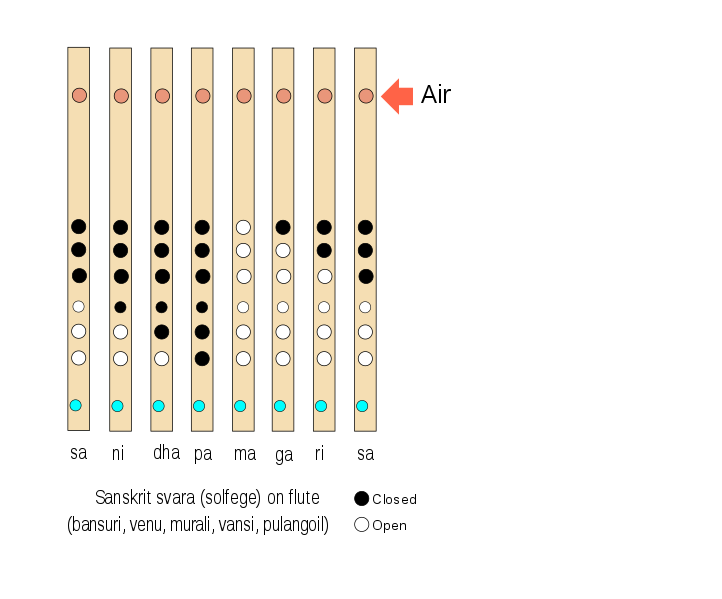 The bamboo flute is a simple yet elegant instrument. The Venu of the South is known for its 8 hole configuration. This is said to give more of a range. The larger the instrument, the more resonant the sound. The smaller the instrument the more reedy the tone. It is considered the most ancient of the transverse flutes.
The bamboo flute is a simple yet elegant instrument. The Venu of the South is known for its 8 hole configuration. This is said to give more of a range. The larger the instrument, the more resonant the sound. The smaller the instrument the more reedy the tone. It is considered the most ancient of the transverse flutes.
Tones and notes are produced by closed hole, half closed hole, and open hole.
Process
A very simple instrument, the bamboo flute is made significant more by the process of maintenance than creation. A Kichaka (bamboo) stalk is typically used, and is cut and then dried. Already hollowed out, one end is closed, and notches are then made for the holes. Finally it is sanded down and oiled. [4]
Oil is critical for maintenance. The standard carnatic flute lasts about 30 years, depending on climate. While a little bit of water may be periodically dabbed for hygiene, it is a good idea to use an oiled rag for the inside, to delay cracking of the instrument.
Interestingly enough, many flautists are flute-makers themselves.
Legacy
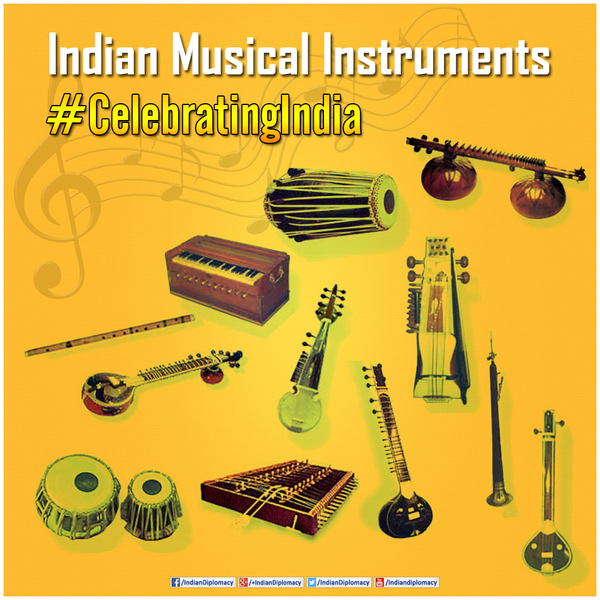
The Murali’s once and always true master will no doubt be the original Muralidhara. Nevertheless, there is a long line of non-cosmic wielders of this cosmically romantic instrument. Obviously, many more are lost to the mists of time, but with respect to available history, here are some notable names for this naadhabrahma aathodhya.
Famous Players
Sarabha Sastry
Srikazhi Narayanaswamy Pillai
Tiruchi Ramachandra Sastri
H. Ramachandra Shastry
T.R Mahalingam
Kudamulur Janardhanan
Indraganta Venkata Lashmana Sastry
Natesan Ramani
Sikkil Mala Chandrasekar
G.S.Rajan
K.Bhaskaran
T.S.Sankaran
D. Muthukumar
T.N.Sivakumar
https://www.youtube.com/watch?v=C2ld4IJeEFI
Mahesh Swamy
Sruthi Sagar
V.K.Raman (Raman Kalyan)
Shashank Subramanyam
Shanthala Subramanyam
Ambale Brothers (Herambha & Hemanth)
Fusion
https://twitter.com/praveenfluteguy/status/989103393825280001
Fusion and Carnatic don’t always go well together, yet, the key to a revival of Indian classical and Indian folk among the masses may lie here. As mentioned above, there are a number of up-and-coming flautists, male and female, who have the potential to spur interest in the traditional through their skill in the instrumental.
Rather than RT’ing the latest antics of some philmi philistine, promote these more cultured folks and spread the word about their talents. The Vamsee deserves revival by virtuoso vamsikas. Raman Kalyan is one such vamsika leading such efforts today.
Future
There are numerous prodigies and talents in Andhra and beyond. It is crucial that musical culture, both classical and folk, be cultivated again.
For far too long has our state (and nation) orbited the phillim universe. Cinema certainly does have value, but it is as important to appreciate music, especially Classical Indic Music, on its own terms.
True, not everyone can be a Thyagaraja, or even an average vocal performer, but everyone has potential for him or her to discover. For those who cannot sing, there are instruments too that one can learn for the benefit of oneself and for the enjoyment of others. Rather than have everyone playing spectator-consumer, it is time for all to start marching to our own tunes and start playing our own instruments. Start today and buy one here or at many of the manufacturers found online.
The virtuoso veena may not be for everyone, so why not try the venu?
https://youtu.be/Xb_O6VYViSg?t=29m42s
References:
- Iyer, A.S. Panchapakesa.Karnataka Sangeeta Sastra: Theory of Carnatic Music.
- Appa Rao, P.S.R & P. Sri Rama Sastry. A Monography on Bharata’s Natya Sastra. Hyderabad: Natyakala Press. 1967.P.110-112
- Pappu, Venugopala Rao. Nrtta Ratnavali of Jaya Senapati. Kakatiya Heritage Trust. 2013.
- http://www.thehindu.com/features/friday-review/religion/the-flute-analogy/article6719880.ece
- Pappu, Venugopala Rao. Nrtta Ratnavali of Jaya Senapati. Kakatiya Heritage Trust. 2013.
- Prajnananda, Swami. A History of Indian Music. Volume Two. Calcutta: Ramakrishna Math. 1998
